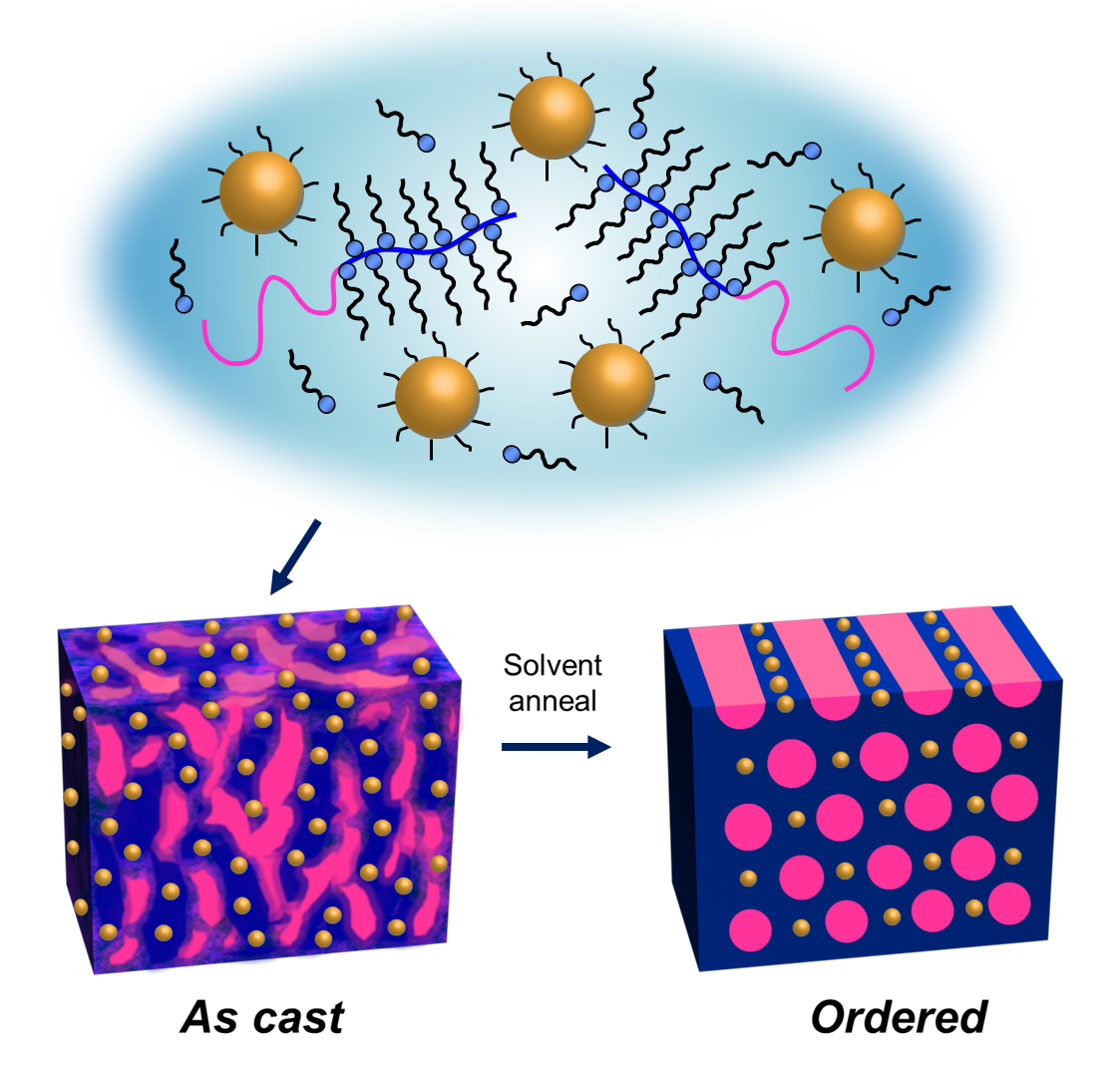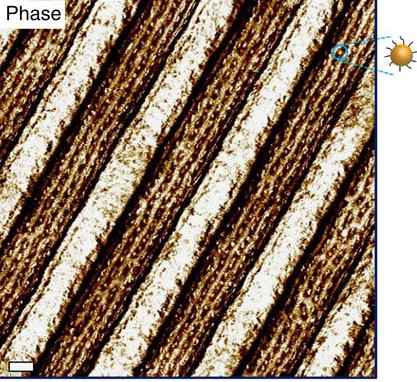Nanoparticle thin films that self-assemble in one minute
June 10, 2014

Upon solvent annealing, supramolecules made from gold nanoparticles and block copolymers will self-assemble into highly ordered thin films in one minute (credit: Berkeley Labs)
Lawrence Berkeley National Laboratory (Berkeley Lab) researchers have devised a technique that allows supramolecules (self-assembling nanoparticle arrays) to form a highly ordered thin film over macroscopic (large-scale) distances in one minute, instead of hours.
The supramolecules are based on block copolymers that were combined with gold nanoparticles to create nanocomposites. Under solvent annealing, these quickly self-assembled into hierarchically structured thin films spanning an area of several square centimeters.
The technique is compatible with current nanomanufacturing processes and has the potential to generate new families of optical coatings for applications in a wide number of areas including solar energy, nanoelectronics and computer memory storage. This technique could even open new avenues to the fabrication of metamaterials, artificial nanoconstructs that possess remarkable optical properties.
“Our technique can rapidly generate amazing nanoparticle assemblies over areas as large as a silicon wafer,” says Ting Xu, a polymer scientist with Berkeley Lab’s Materials Sciences Division. “You can think of it as pancake batter that you can spread over a griddle, wait one minute and you have a pancake ready to eat.”
Xu is the corresponding author of a paper describing this research in Nature Communications.
Nanoparticles function as artificial atoms with unique optical, electrical and mechanical properties. If nanoparticles can be induced to self-assemble into complex structures and hierarchical patterns, similar to what nature does with proteins, it would enable mass-production of devices a thousand times smaller those used in today’s microtechnology.

AFM phase image shows a 50-nm nanocomposite thin film in lithographically patterned trenches that formed unidirectional nanoparticle arrays over macroscopic distances in just over a minute. The bright circular dots represent the 5 nm gold nanoparticles as illustrated by the schematic. (Credit: Berkeley Lab)
Xu and her research group are using block-copolymer-based supramolecular solutions to direct the self-assembly of nanoparticle arrays.
A supramolecule is a group of molecules that act as a single molecule able to perform a specific set of functions.
Block copolymers are long sequences or “blocks” of one type of monomer bound to blocks of another type of monomer that have an innate ability to self-assemble into well-defined arrays of nano-sized structures over macroscopic distances.
“Block copolymer-based supramolecules self-assemble and form a wide range of morphologies that feature microdomains typically a few to tens of nanometers in size,” Xu says. “As their size is comparable to that of nanoparticles, the microdomains of supramolecules provide an ideal structural framework for the self-assembly of nanoparticle arrays.”
In the supramolecular technique devised by Xu and her colleagues, arrays of gold nanoparticles were incorporated into solutions of supramolecules to form films that were about 200 nanometers thick.
“To be compatible with nanomanufacturing processes, the self-assembly fabrication process must also be completed within a few minutes to minimize any degradation of nanoparticle properties caused by exposure to the processing environment,” Xu says.
“We should be able to create a library of nanoparticle assemblies engineered for light manipulation and other properties,” Xu says, “using a technique that is compatible with today’s most widely used nanomanufacturing processes, including blade coating, ink-jet printing and dynamic zone annealing.”
This research was funded by the DOE Office of Science and made use of the Advanced Photon Source at Argonne National Laboratory, a DOE Office of Science user facility.
Abstract of Nature Communications paper
Functional nanocomposites containing nanoparticles of different chemical compositions may exhibit new properties to meet demands for advanced technology. It is imperative to simultaneously achieve hierarchical structural control and to develop rapid, scalable fabrication to minimize degradation of nanoparticle properties and for compatibility with nanomanufacturing. Here we show that the assembly kinetics of supramolecular nanocomposites in thin films are governed by the energetic cost arising from defects, the chain mobility and the activation energy for inter-domain diffusion. By optimizing only one parameter, the solvent fraction in the film, the assembly kinetics can be precisely tailored to produce hierarchically structured thin films of supramolecular nanocomposites in one minute. Moreover, the strong wavelength-dependent optical anisotropy in the nanocomposite highlights their potential applications for light manipulation and information transmission. The present study may open a new avenue in designing manufacture-friendly continuous processing for the fabrication of functional nanocomposite thin films.